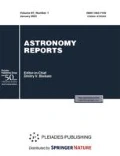Abstract
Seven early-type galaxies that are members of the massive X-ray group containing NGC 80 have been studied using two-dimensional spectroscopy with the 6-m telescope of the Special Astrophysical Observatory. We searched for evidence for the synchronous secular evolution of the galaxies in the group. The bulges of five of the seven galaxies appear to be old, with the average age of the bulge stars being 10–15 billion years. Signs of a relatively recent star-formation burst are observed in the small S0 galaxy IC 1548, whose average bulge age is 3 billion years and average core age is 1.5 billion years. A circumnuclear polar gas ring was also detected in this galaxy; in its outer regions, it makes a smooth transition to a gas disk that counter-rotates relative to the stars. IC 1548 probably underwent a close interaction, which resulted in its transformation from a spiral to a lenticular galaxy; the same interaction may also have induced the central burst of star formation. In the giant E0 galaxy NGC 83, a compact massive stellar-gas disk with a radius of about 2 kpc and very rapid rotation is observed, with ongoing star formation; the so-called “minor merger” is likely to have occurred there. We conclude that the NGC 80 group is in a state of formation, with the small NGC 83 subgroup “falling into” the large, old NGC 80 subgroup.
Similar content being viewed by others
References
J. Kormendy and R. C. Kennicutt, Jr., Ann. Rev. Astron. Astrophys. 42, 603 (2004).
O. K. Sil’chenko, A. V. Moiseev, V. L. Afanasiev, et al., Astrophys. J. 591, 185 (2003).
O. K. Sil’chenko, V. L. Afanasiev, V. H. Chavushyan, and J. R. Valdes, Astrophys. J. 577, 668 (2002).
O. K. Sil’chenko and V. L. Afanasiev, Pis’ma Astron. Zh. 32, 592 (2006) [Astron. Lett. 32, 534 (2006)].
V. L. Afanasiev and O. K. Sil’chenko, Astron. Astrophys. 429, 825 (2005).
V. L. Afanasiev and O. K. Sil’chenko, Astron. Astrophys. Trans. 26, 311 (2007).
M. Ramella, M. J. Geller, A. Pisano, and L. N. da Costa, Astron. J. 123, 2976 (2002).
I. P. Dell’Antonio, M. J. Geller, and D. G. Fabricant, Astron. J. 107, 427 (1994).
A. Mahdavi and M. J. Geller, Astrophys. J. 607, 202 (2004).
A. Mahdavi, H. Bohringer, M. J. Geller, and M. Ramella, Astrophys. J. 534, 114 (2000).
G. D. Bothun and R. A. Schommer, Astrophys. J. Lett. 267, L15 (1983).
V. L. Afanasiev, S. N. Dodonov, and A. V. Moiseev, in: Stellar Dynamics: From Classic to Modern, Ed. by L. P. Osipkov and I. I. Nikiforov (St. Petersburg: St. PetersburgUniv. Press, 2001), p. 103.
G. Worthey, S. M. Faber, J. J. Gonzàlez, and D. Burstein, Astrophys. J. Suppl. Ser. 94, 687 (1994).
G. Worthey, Astrophys. J. Suppl. Ser. 95, 107 (1994).
D. Thomas, C. Maraston, and R. Bender, Mon. Not. Roy. Astron. Soc. 339, 897 (2003).
V. L. Afanasiev and A. V. Moiseev, Pis’ma Astron. Zh. 31, 214 (2005) [Astron. Lett. 31, 194 (2005)].
O. K. Sil’chenko, S. E. Koposov, V. V. Vlasyuk, and O. I. Spiridonova, Astron. Zh. 80, 107 (2003) [Astron. Rep. 47, 88 (2003)].
G. Stasinska and I. Sodre, Jr., Astron. Astrophys. 374, 919 (2001).
S. C. Trager, S. M. Faber, G. Worthey, and J. J. Gonzàlez, Astron. J. 119, 1645 (2000).
T. Wiklind, F. Combes, and C. Henkel, Astron. Astrophys. 297, 643 (1995).
L.M. Young, Astrophys. J. 634, 258 (2005).
O. K. Sil’chenko, Pis’ma Astron. Zh. 31, 250 (2005) [Astron. Lett. 31, 227 (2005)].
O. K. Sil’chenko and A. V. Moiseev, Astron. J. 131, 1336 (2006).
D. Friedli and W. Benz, Astron. Astrophys. 268, 65 (1993).
J. Kormendy, Astrophys. J. 257, 75 (1982).
Author information
Authors and Affiliations
Additional information
Original Russian Text © O.K. Silchenko, V.L. Afanasiev, 2008, published in Astronomicheskiĭ Zhurnal, 2008, Vol. 85, No. 11, pp. 972–985.
Rights and permissions
About this article
Cite this article
Silchenko, O.K., Afanasiev, V.L. The stellar population and evolution of galaxies of the NGC 80 group. Astron. Rep. 52, 875–887 (2008). https://doi.org/10.1134/S1063772908110024
Received:
Accepted:
Published:
Issue Date:
DOI: https://doi.org/10.1134/S1063772908110024




